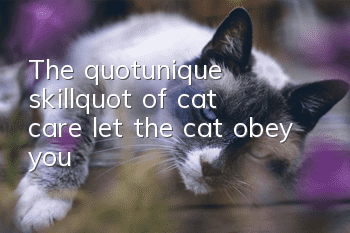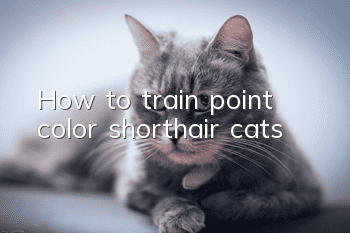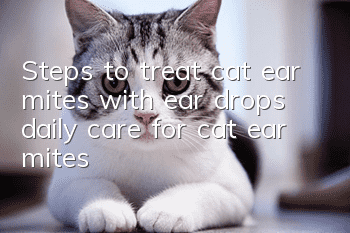The "unique skill" of cat care, let the cat obey you!

Many pet shops are unwilling to accept cats because too many cats are resistant to unfamiliar environments and are "wild and untamable". Once they get wet, their teeth and claws will go into battle, making beauticians avoid them.
At this time, you need a trick called "Cute Cat Petrification Technique" to make the cat motionless and obedient, leaving it at the mercy of others (due to individual differences among cats, this trick does not apply to all cats).
Weakness: Back of neck
Many times we find that once we hold the back of the cat’s neck, the cat will become petrified.
Some people think that the back of a cat's neck is "dead meat" and will not feel pain if bitten or pinched. Therefore, big cats will choose to hold this part in their mouths when traveling with kittens.
Some people also think that this position belongs to the cat’s nerve channel. Once it is picked up, its motor nerves will be blocked, so the whole body cannot move.
However, both of these statements are scientifically untenable, so what is the real reason?
Pinch-induced behavioral inhibition
Guoke netizen, Shanshan DVM, an American doctoral student in clinical medicine and master of animal science, answered this question.
This phenomenon is called "clipnosis", which is a compound of the words "clip" and "hypnosis". Many scientists have conducted in-depth research on this phenomenon.
The experiment invited 31 cats of different genders, ranging from 1 to 5 years old, to participate, and the 2-inch binder in the picture above is the magic tool for "pointing". A cat whose neck is clamped will stop moving, arch its back, and tuck its tail between its legs (like the picture below).
Image source: Shanshan DVM, Guoke.com
After testing various physiological indicators of cats, researchers found that the cat’s behavior was not caused by fear or pain. The cat’s pupils did not dilate, her heart rate did not increase, and her breathing rate was normal—all of the physiological responses that a frightened animal would normally have. The research team concluded that this behavior in cats is related to "the convenience of moving kittens."
In the paper, a more appropriate phrase is used to describe this behavior of cats: "Pinch""Pinch-induced behavioral inhibition phenomenon". In fact, the phenomenon of young animals showing a "pointed" state after being picked up by their mother exists in many species, including mice, rats, rabbits, dogs, guinea pigs, etc. < /p>
Mom, the lion who had a second child, could only take one cub across the river.
Cerebellum has a look of despair
Squirrel Mama moves with her hairless cub
Panda cub: Mom, let me go, my national treasure has no face.
Mama is going to transfer herself
Regarding this pinch-induced behavioral inhibition phenomenon, Japanese neurobiologists conducted an experiment in 2013. Since this phenomenon occurs in many mammals, their experimental subjects were young rats.
In the experiment, they anesthetized the nerves that sense movement in the necks of young rats. After that, the "sedative effect" caused by being "picked up" weakened. Also, surgical removal of part of the brain to disrupt incoming signals from the cerebellar cortex also lengthened the time it took for the mother to calm her pups. If it cannot sense that the back of the neck is being grabbed, the young rat will not curl up; if the cerebellum cannot receive the signal, the young rat will not be obedient.
The weakening of the heartbeat and changes in body posture are directly realized by the parasympathetic nerves and the efferent nerves of the cerebellum. This series of physiological reactions makes the baby rats quiet, obedient, and curled up, making it easier for the mother rat to take them to a safe place.
Therefore, it is not that "the meat on the back of the cat's neck is dead", on the contrary, it is the receptor nerves on the back of the neck that allow the kitten to get the signal "I am being picked up"; and the subsequent physiological reactions similar to "being tapped" are not It's not because "the nerve channels are blocked", but because the signals from the brain guide them to have physiological phenomena that facilitate "numb transfer themselves".
The next time you wash your cat, try gently holding the back of the cat’s neck to see if you can “petrify” it.
TIPS: Because some cats have never experienced being moved around in their mouths when they were young, or due to their own personality reasons, the "cat petrification technique" may also fail.
- Do Ragdoll cats need to supplement taurine every day? A must-read for novices!
- How to prevent cats from wandering at night? Get rid of cats’ “nocturnal wandering syndrome”!
- How to deworm your pets regularly?
- Somali cat food taboos
- How to train a cat? Cats can be trained like this!
- Should the cat food eaten by a three-month-old cat be soaked?
- How intelligent is a Burmese cat?
- What will the 25-color golden gradient look like when it grows up? Will it turn black?
- Why is the cat foaming at the foam but in good spirits?
- What causes cloudy eyes in cats? Diseases of cat eyes!



